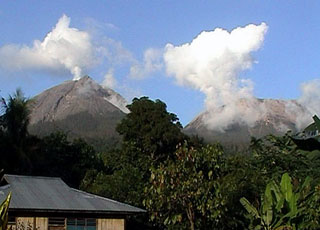Report on Lewotobi (Indonesia) — 28 February-5 March 2024
Smithsonian Institution / US Geological Survey
Weekly Volcanic Activity Report, 28 February-5 March 2024
Managing Editor: Sally Sennert.
Please cite this report as:
Global Volcanism Program, 2024. Report on Lewotobi (Indonesia) (Sennert, S, ed.). Weekly Volcanic Activity Report, 28 February-5 March 2024. Smithsonian Institution and US Geological Survey.
Lewotobi
Indonesia
8.542°S, 122.775°E; summit elev. 1703 m
All times are local (unless otherwise noted)
PVMBG reported that white plumes rose as high as 300 m above the summit of Lewotobi’s Laki-laki volcano during 28 February-5 March. According to a news article, seismicity and visual observations showed that activity decreased during 22-29 February. Drone footage indicated that the lava flow was cooling, and effusion had stopped, though the flow may continue to slowly advance due to gravity, the slope of the ground, and the high temperature. PVMBG lowered the Alert Level to 2 (the second lowest level on a scale of 1-4) at 1900 on 1 March and the public was warned to stay outside of the exclusion zone, defined as a 2-km radius around Laki-laki crater, 3 km to the NNE, and 5 km on the NE flanks.
Geological Summary. The Lewotobi edifice in eastern Flores Island is composed of the two adjacent Lewotobi Laki-laki and Lewotobi Perempuan stratovolcanoes (the "husband and wife"). Their summits are less than 2 km apart along a NW-SE line. The conical Laki-laki to the NW has been frequently active during the 19th and 20th centuries, while the taller and broader Perempuan has had observed eruptions in 1921 and 1935. Small lava domes have grown during the 20th century in both of the summit craters, which are open to the north. A prominent cone, Iliwokar, occurs on the E flank of Perampuan.
Sources: Pusat Vulkanologi dan Mitigasi Bencana Geologi (PVMBG, also known as CVGHM), Antara News

